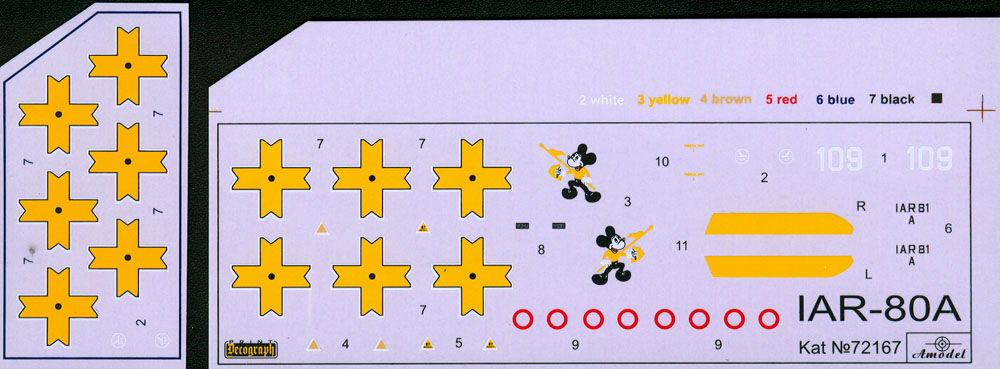History
First flown in 1939, the IAR-80 was Romania's answer to Germany's Bf 109 and Britain's Spitfire. A low-wing monoplane powered by a Gnome-Rhône engine, the IAR-80 was a maneuverable aircraft that pilots enjoyed flying, even if it was not up to its German and British counterparts in terms of top speed. Initially, the IAR-80 suffered from armament issues due to the opening stages of the Second World War. The aircraft initially was armed with Belgian 7.92mm machine guns, but the German invasion of the Low Countries cut off that supply. By the time the IAR-80A came around with its more powerful engine, the supply of Belgian FN guns was once again open, this time via the Germans, and the aircraft could finally fly with its full complement of six guns.
The operational record of the IAR-80 was minimal, given its limited production and limited operational area, but it still gave a good accounting. During the Ploesti raid, Romanian IAR-80s claimed eight P-38s for the loss of only one IAR-80. The high maneuverability of the aircraft was put to good use in that battle, and had the plane had better armament the outcome could have been even more lopsided.
The Kit
Molded in light gray plastic, this latest release from Amodel shows some of the refinements this company has made over the years. The detailing on the parts is crisper, and the level of detail, both inside and out, is impressive. There are a fair number of parts marked as not for use, indicating other variants that we will undoubtedly see before long. The decal sheet provides markings for a single aircraft.Starting with the interior, this is a combination of separate parts and molded-on detail to the fuselage sides. The main cockpit floor is actually an open arrangement, with no solid cockpit floor. Instead, there are slats for the feet and a simple bucket seat. The rear of the seat is separate, while the rest is molded in place with the 'floor'. A separate control stick and rudder pedals are also included. This assembly then fits between the fuselage halves, with a two-piece instrument panel assembly and a separate headrest/bulkhead completing the main cockpit assembly. Sidewall details include various boxes, most likely representations of the radio and throttle. When suitably painted and weathered, this should look quite good under the one-piece canopy.
The fuselage assembly is somewhat complex, with the forward fuselage separate from the rear fuselage. The cowling is also separate, with a separate front cowl ring. This means that the entire fuselage assembly is made up of seven pieces, which could result in some serious alignment issues. This will definitely be a case of test-fit repeatedly before gluing. While on the subject of the cowling, this encases a decent engine, with the kit including both rows of cylinders. The exhaust pipes are accurate in shape and have a bit of an indentation for the actual pipe. A bit of work with a grinder will increase the realism on these parts without much effort. Moving on to the wings, these are made up from three parts (in fact, if you consider the center portion of the lower wing, the fuselage is actually made up from eight pieces). The control surfaces are molded into the upper wing, resulting in some thin trailing edges. The main wheel wells are a separate insert and are rather plain. However, not having seen the interior of an IAR-80 wheel well, it could be that they are that plain. For the tailplanes, these are solid pieces, right and left, that are butt-jointed to the fuselage. I would recommend working carefully here, as misaligned tailplanes really stand out. For the final details, the landing gear is solid, with one-piece gear legs and separate actuator arms. The wheels are separate, fitting between the gear forks. The gear doors are detailed inside and out, and only really need a touch of thinning down to really look sharp. The wing guns, pitot tube, aileron mass balances, tail support struts, fuselage antenna, and tail skid are all separate. Some may wish to replace some of these with plastic rod, if for no other reason than it would be easier to do so than trimming these small parts from their sprues. The single decal option is the IAR-80A flown by Constantin Pomut in 1941-1942. This plane is camouflaged in brown and green on the upper surfaces, with the undersides finished in a light blue. The cowling, wingtip undersides, and a large fuselage band are yellow. The decals provide the yellow stripe for the rudder, leaving the modeler to paint the blue and red (some may opt to paint all three colors, to have the yellows match between the cowling and fuselage band). The decals include the national insignia, with the center red ring provided separately to improve alignment. The personal markings of Pomut include a Mickey Mouse emblem on the fuselage sides, while the aircraft number '109' is on the tail in white. Other details include the manufacturer's logo, fuel filler markings, and other stenciling.Conclusion
The IAR-80 is a fascinating aircraft, and this model looks to be one of the better renditions in plastic. While some of the assembly is complex, it should go together fairly easily, and will make for a great addition to a WW2 model collection. My thanks to Scale Model Kits for the review sample.
